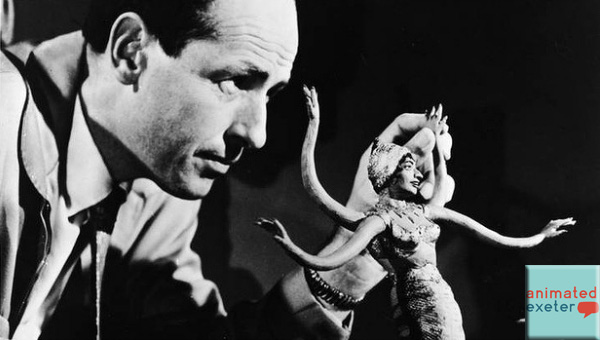 Animated Exeter 2013 has chosen to open this year’s festival with what might seem like an unusual choice of films. RAY HARRYHAUSEN: SPECIAL EFFECTS TITAN is a detailed and engaging insight into the career of the most influential special effects artist and stop motion animator in motion picture history. The film doesn’t deal with the type of hyper real animation you might expect to be canonised in an animation festival. Instead it focuses on the wider influence of the animation industry, and reminds us of the central role it plays in contemporary mainstream cinema.
Animated Exeter 2013 has chosen to open this year’s festival with what might seem like an unusual choice of films. RAY HARRYHAUSEN: SPECIAL EFFECTS TITAN is a detailed and engaging insight into the career of the most influential special effects artist and stop motion animator in motion picture history. The film doesn’t deal with the type of hyper real animation you might expect to be canonised in an animation festival. Instead it focuses on the wider influence of the animation industry, and reminds us of the central role it plays in contemporary mainstream cinema.
If you’re of a certain age, Ray Harryhausen’s nightmarish hallucinations were probably your first introduction to Medusa, sword fighting skeletons, giant octopus tentacles and Greek mythology. His animations, models and live action integration are unforgettable as they flaunt a creepy level of realism and a hugely appealing idiosyncratic style. Therefore, whether you are a visual effects buff or not, Harryhausen’s description of his own technique is enthralling in this well organised biopic documentary, which unfortunately descends into the tired and redundant debate of CGI versus non-CGI.
His animations were a huge evolutionary leap in spectacle film making…
A handful of stop motion animators and a host of contemporary directors, most of whom are famous for large-scale computer generated special effects films, intermittently honour Harryhausen’s legacy throughout. It’s clear that director Gilles Penso’s intention with SPECIAL EFFECTS TITAN is to illustrate the colossal impact of Harryhausen’s work on contemporary cinema and visual effects. In this respect he is hugely successful; however, many of the selected sound bites from special effects supervisors, directors and animators refute CGI while celebrating Harryhausen’s stories and techniques, often admitting to plagiarism of his ideas. These criticisms of CGI are frustratingly shortsighted, ill-informed and do a grave disservice to Harryhausen’s work and legacy.
 The power of stop motion lies in its relevance to the stories it tells. It is the perfect companion for the tales of great and fantastic legend told by Harryhausen and the directors he worked with. If contemporary audiences aren’t receptive to CGI in contemporary films, as claimed by Spielberg, it might be suggested that the medium is not best suited to tell that particular story. This is a rudimentary principle of design, and it seems naïve for an experienced director to suggest that CGI is inferior to other formats.
The power of stop motion lies in its relevance to the stories it tells. It is the perfect companion for the tales of great and fantastic legend told by Harryhausen and the directors he worked with. If contemporary audiences aren’t receptive to CGI in contemporary films, as claimed by Spielberg, it might be suggested that the medium is not best suited to tell that particular story. This is a rudimentary principle of design, and it seems naïve for an experienced director to suggest that CGI is inferior to other formats.
Such accusations might be more convincing if Harryhausen’s brilliant technique wasn’t almost identical to the computer animation process. In both cases, a character is sculpted around a skeleton that enables the model to be animated by the artist. The character is then animated and the film or backplate is split into layers to allow the animated character to be composited into the scene. This technique, developed and used by Ray Harryhausen, is also an explanation (simplified to the extreme) of how computer generated images are integrated into contemporary film. To cite a cliché, “if it isn’t broke, don’t fix it”.
Ray Harryhausen’s legacy is not jerky Dynomation; it is the talented artists who continue to innovate with his techniques…
What these cynical contributors are perhaps failing to take into consideration is that Ray Harryhausen is a powerhouse of creativity and originality. His films, although influenced by earlier invocations of the monster movie, realised that same horror with a clarity far beyond anything the world had seen before. His animations were a huge evolutionary leap in spectacle film making, which is why they were so powerful and revered.
CGI is no more or less effective than stop motion, but like all mediums it is not a fix all solution: it has a significance all of its own. We should not be remembering Ray Harryhausen for his masterful use of time consuming and now outdated technology. We should be celebrating a man who mastered his art form by developing techniques that are we still use today in contemporary media. Ray Harryhausen’s legacy is not jerky Dynomation; it is the talented artists who continue to innovate with his techniques and create stunning animation and visual effects that draw audiences into cinemas today.


One thought on “Ray Harryhausen : Special Effects Titan”
Comments are closed.